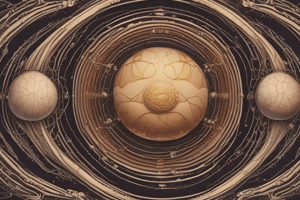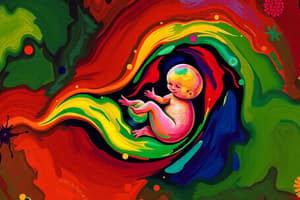Podcast
Questions and Answers
What key event signifies the end of the germinal stage and the beginning of the embryonic stage?
What key event signifies the end of the germinal stage and the beginning of the embryonic stage?
- Fertilization of the egg by a sperm
- Formation of the zygote
- The start of cell division through mitosis
- Implantation of the blastocyst in the uterine wall (correct)
The fetal stage is primarily characterized by the formation of major organs and body systems.
The fetal stage is primarily characterized by the formation of major organs and body systems.
False (B)
During which prenatal stage is the developing organism most susceptible to the harmful effects of teratogens?
During which prenatal stage is the developing organism most susceptible to the harmful effects of teratogens?
embryonic stage
The protective coating that develops on the skin of the fetus during the second trimester is called the ______.
The protective coating that develops on the skin of the fetus during the second trimester is called the ______.
Match the primary germ layers with the structures they develop into:
Match the primary germ layers with the structures they develop into:
Which of the following occurs during the germinal stage of prenatal development?
Which of the following occurs during the germinal stage of prenatal development?
Quickening, the first fetal movements felt by the mother, typically occurs during the third trimester.
Quickening, the first fetal movements felt by the mother, typically occurs during the third trimester.
What is the name given to environmental agents that can cause birth defects?
What is the name given to environmental agents that can cause birth defects?
During prenatal development, the structure that eventually becomes the brain and spinal cord is the ______.
During prenatal development, the structure that eventually becomes the brain and spinal cord is the ______.
Match the teratogen with its potential effect on prenatal development:
Match the teratogen with its potential effect on prenatal development:
What is the correct order of the stages of prenatal development?
What is the correct order of the stages of prenatal development?
The sex of the fetus can be determined by ultrasound during the first month of pregnancy.
The sex of the fetus can be determined by ultrasound during the first month of pregnancy.
What is the term for the fine hair that covers the fetus's body during the second trimester?
What is the term for the fine hair that covers the fetus's body during the second trimester?
Mitosis is the process of ______ division that occurs during the germinal stage.
Mitosis is the process of ______ division that occurs during the germinal stage.
Match the event with the trimester in which it typically occurs:
Match the event with the trimester in which it typically occurs:
Which of the following is NOT a potential effect of smoking during pregnancy?
Which of the following is NOT a potential effect of smoking during pregnancy?
Failure of the blastocyst to implant in the uterine wall always results in a recognized miscarriage.
Failure of the blastocyst to implant in the uterine wall always results in a recognized miscarriage.
What is the significance of the fetus receiving antibodies from the mother during the third trimester?
What is the significance of the fetus receiving antibodies from the mother during the third trimester?
The process of organ formation that takes place during the embryonic stage is called ______.
The process of organ formation that takes place during the embryonic stage is called ______.
Match the following structures with their approximate time of initial development:
Match the following structures with their approximate time of initial development:
Flashcards
Prenatal Development
Prenatal Development
The period from conception to birth, marked by biological transformations.
Germinal Stage
Germinal Stage
The first stage of prenatal development, lasting about two weeks, from conception to implantation.
Mitosis in Zygote
Mitosis in Zygote
Cell division process that occurs as the zygote travels down the fallopian tube.
Blastocyst
Blastocyst
A sphere of cells with a fluid-filled cavity formed about four days after fertilization.
Signup and view all the flashcards
Embryonic Stage
Embryonic Stage
The stage from implantation through the eighth week of gestation, during which major organs form.
Signup and view all the flashcards
Organogenesis
Organogenesis
The process of major organ and body system formation during the embryonic stage.
Signup and view all the flashcards
Ectoderm
Ectoderm
Outer layer > skin, hair, nails, sensory organs, and the nervous system.
Signup and view all the flashcards
Mesoderm
Mesoderm
Middle layer > muscles, skeleton, blood vessels, heart, and reproductive organs.
Signup and view all the flashcards
Endoderm
Endoderm
Inner layer > digestive system, liver, pancreas, respiratory system, and other internal organs.
Signup and view all the flashcards
Fetal Stage
Fetal Stage
The stage from the ninth week until birth, characterized by rapid growth and organ system refinement.
Signup and view all the flashcards
Vernix Caseosa
Vernix Caseosa
A protective coating that develops on the skin of the fetus during the second trimester.
Signup and view all the flashcards
Lanugo
Lanugo
Fine hair that covers the body of the fetus during the second trimester.
Signup and view all the flashcards
Teratogens
Teratogens
Environmental agents that can disrupt prenatal development and cause birth defects.
Signup and view all the flashcards
Fetal Alcohol Spectrum Disorders (FASDs)
Fetal Alcohol Spectrum Disorders (FASDs)
Disorders from alcohol during pregnancy, causing physical, cognitive, and behavioral abnormalities.
Signup and view all the flashcards
Risks of Smoking During Pregnancy
Risks of Smoking During Pregnancy
Low birth weight, premature birth, and increased risk of SIDS.
Signup and view all the flashcards
Importance of Prenatal Care
Importance of Prenatal Care
Avoiding teratogens and receiving vaccinations.
Signup and view all the flashcards
Zygote
Zygote
The fertilized ovum before it becomes an embryo.
Signup and view all the flashcards
Implantation
Implantation
When the blastocyst attaches to the uterine wall.
Signup and view all the flashcards
Neural Tube
Neural Tube
The neural tube develops into the brain and spinal chord.
Signup and view all the flashcards
Quickening
Quickening
When the mother begins to feel fetal movement.
Signup and view all the flashcardsStudy Notes
- Prenatal development includes conception to birth, marked by biological changes
- Prenatal development is commonly divided into three trimesters, each notable for its milestones
Germinal Stage
- The germinal stage is the first and shortest, lasting approximately two weeks, from conception to implantation
- Fertilization sees a sperm penetrate an egg, creating a zygote
- The zygote undergoes cell division via mitosis while traveling down the fallopian tube
- After four days the zygote becomes a blastocyst, a fluid filled sphere of cells
- Around day 10 the blastocyst implants in the uterine wall initiating pregnancy
- Implantation results in hormonal changes to sustain pregnancy and prevent menstruation
- If implantation fails the pregnancy terminates, often without the woman knowing
Embryonic Stage
- The embryonic stage spans from implantation to the eighth week of gestation
- During this time major organs and systems form via organogenesis
- The embryo develops three key layers: the ectoderm (outer), mesoderm (middle), and endoderm (inner)
- The ectoderm develops into skin, hair, sensory organs, nails, and the nervous system
- The mesoderm becomes muscles, skeleton, reproductive organs, blood vessels and the heart
- The endoderm forms the digestive, respiratory system, pancreas, liver and other internal organs
- By the end of the embryonic stage, all major organs and body parts are present, though rudimentary
- The heart begins beating around week five
- Early in this stage the neural tube which becomes the brain and spinal cord develops
- During this period the embryo faces greatest risk from teratogens which can cause birth defects
Fetal Stage
- The fetal stage spans from the ninth week until birth
- This stage features rapid growth and refinement of organ systems
- Size and weight of the fetus increase significantly
- By the end of month three, the fetus can move its limbs and head
- External genitalia are developed, and sex can be determined via ultrasound
- During the second trimester (months 4-6), the mother begins to feel fetal movements (quickening)
- Vernix caseosa, a protective coating, develops on the skin
- Fine hair known as lanugo covers the body
- The brain of the fetus develops quickly
- The organ systems of the fetus continue to mature
- By the end of the second trimester, the fetus has a good chance of survival if born prematurely with intensive medical care
- During the third trimester (months 7-9), the fetus grows rapidly, and organ systems mature
- The lungs mature, preparing to breathe
- The fetus develops antibodies from the mother offering immunity after birth
- The brain continues to develop, and the fetus responds more to external stimuli
- In preparation for birth the fetus generally moves into a head-down position
Teratogens
- Teratogens are environmental agents that can disrupt prenatal development and cause birth defects
- Common teratogens include drugs, alcohol, tobacco, certain medications, environmental toxins, and maternal infections
- A teratogen's effect depends on the dose, exposure timing, and genetic susceptibility of the fetus
- The embryonic stage is the most sensitive to the effects of teratogens, because the major organs are developing
- Alcohol consumption during pregnancy can cause fetal alcohol spectrum disorders (FASDs), which can cause physical, cognitive, and behavioral abnormalities
- Smoking during pregnancy is associated with low birth weight and premature birth as well as an increased risk of sudden infant death syndrome (SIDS)
- Certain medications like thalidomide and isotretinoin (Accutane), are known to cause severe birth defects
- Environmental toxins like lead, mercury, and radiation, can also harm the developing fetus
- Maternal infections, like rubella, cytomegalovirus (CMV), and Zika virus can cause serious birth defects
- Prenatal care and vaccinations, including avoiding teratogens, can lower the risk of birth defects
Studying That Suits You
Use AI to generate personalized quizzes and flashcards to suit your learning preferences.




